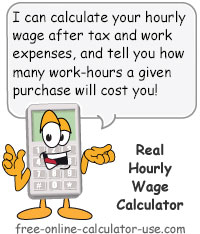IMPORTANT: Numeric entry fields must not contain dollar signs, percent signs, commas, spaces, etc. (only digits 0-9 and decimal points are allowed).
Click the Terms tab above for a more detailed description of each entry.
Step #1:
Enter your average take-home pay and select your pay period.
Step #2:
Complete all applicable entries in the "Time Allocated to Work" section.
Step #3:
Complete all applicable entries in the "Unreimbursed Expenses" section.
Step #4:
Click the "Calculate Real Hourly Wage" button. This will display your profit results along with an interactive "Money to Time" form and a button for generating a printer friendly RHW report that you can print out and take with you.


Follow me on any of the social media sites below and be among the first to get a sneak peek at the newest and coolest calculators that are being added or updated each month.